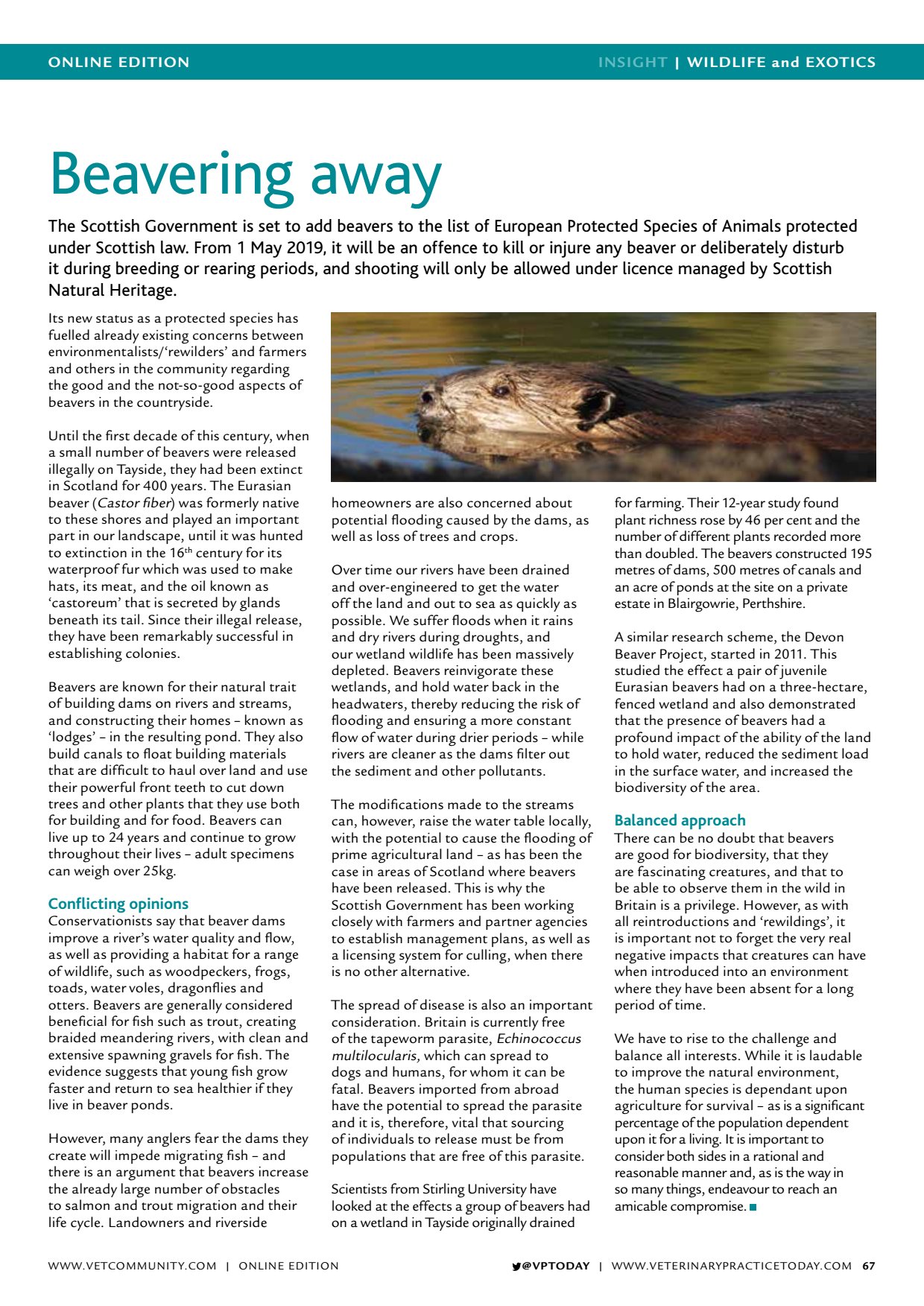Beavering away Conflicting
INSIGHT | WILDLIFE and EXOTICS VPTODAY | WWW.VETERINARYPRACTICETODAY.COM 67 Beavering away The Scottish Government is set to add beavers to the list of European Protected Species of Animals protected under Scottish law. From 1 May 2019, it will be an offence to kill or injure any beaver or deliberately disturb it during breeding or rearing periods, and shooting will only be allowed under licence managed by Scottish Natural Heritage. Its new status as a protected species has fuelled already existing concerns between environmentalists/rewilders and farmers and others in the community regarding the good and the not-so-good aspects of beavers in the countryside. Until the first decade of this century, when a small number of beavers were released illegally on Tayside, they had been extinct in Scotland for 400 years. The Eurasian beaver (Castor fiber) was formerly native to these shores and played an important part in our landscape, until it was hunted to extinction in the 16 th century for its waterproof fur which was used to make hats, its meat, and the oil known as castoreum that is secreted by glands beneath its tail. Since their illegal release, they have been remarkably successful in establishing colonies. Beavers are known for their natural trait of building dams on rivers and streams, and constructing their homes known as lodges in the resulting pond. They also build canals to float building materials that are difficult to haul over land and use their powerful front teeth to cut down trees and other plants that they use both for building and for food. Beavers can live up to 24 years and continue to grow throughout their lives adult specimens can weigh over 25kg. Conflicting opinions Conservationists say that beaver dams improve a rivers water quality and flow, as well as providing a habitat for a range of wildlife, such as woodpeckers, frogs, toads, water voles, dragonflies and otters. Beavers are generally considered beneficial for fish such as trout, creating braided meandering rivers, with clean and extensive spawning gravels for fish. The evidence suggests that young fish grow faster and return to sea healthier if they live in beaver ponds. However, many anglers fear the dams they create will impede migrating fish and there is an argument that beavers increase the already large number of obstacles to salmon and trout migration and their life cycle. Landowners and riverside homeowners are also concerned about potential flooding caused by the dams, as well as loss of trees and crops. Over time our rivers have been drained and over-engineered to get the water off the land and out to sea as quickly as possible. We suffer floods when it rains and dry rivers during droughts, and our wetland wildlife has been massively depleted. Beavers reinvigorate these wetlands, and hold water back in the headwaters, thereby reducing the risk of flooding and ensuring a more constant flow of water during drier periods while rivers are cleaner as the dams filter out the sediment and other pollutants. The modifications made to the streams can, however, raise the water table locally, with the potential to cause the flooding of prime agricultural land as has been the case in areas of Scotland where beavers have been released. This is why the Scottish Government has been working closely with farmers and partner agencies to establish management plans, as well as a licensing system for culling, when there is no other alternative. The spread of disease is also an important consideration. Britain is currently free of the tapeworm parasite, Echinococcus multilocularis, which can spread to dogs and humans, for whom it can be fatal. Beavers imported from abroad have the potential to spread the parasite and it is, therefore, vital that sourcing of individuals to release must be from populations that are free of this parasite. Scientists from Stirling University have looked at the effects a group of beavers had on a wetland in Tayside originally drained for farming. Their 12-year study found plant richness rose by 46 per cent and the number of different plants recorded more than doubled. The beavers constructed 195 metres of dams, 500 metres of canals and an acre of ponds at the site on a private estate in Blairgowrie, Perthshire. A similar research scheme, the Devon Beaver Project, started in 2011. This studied the effect a pair of juvenile Eurasian beavers had on a three-hectare, fenced wetland and also demonstrated that the presence of beavers had a profound impact of the ability of the land to hold water, reduced the sediment load in the surface water, and increased the biodiversity of the area. Balanced approach There can be no doubt that beavers are good for biodiversity, that they are fascinating creatures, and that to be able to observe them in the wild in Britain is a privilege. However, as with all reintroductions and rewildings, it is important not to forget the very real negative impacts that creatures can have when introduced into an environment where they have been absent for a long period of time. We have to rise to the challenge and balance all interests. While it is laudable to improve the natural environment, the human species is dependant upon agriculture for survival as is a significant percentage of the population dependent upon it for a living. It is important to consider both sides in a rational and reasonable manner and, as is the way in so many things, endeavour to reach an amicable compromise. WWW.VETCOMMUNIT Y.COM | ONLINE EDITION ONLINE EDITION
